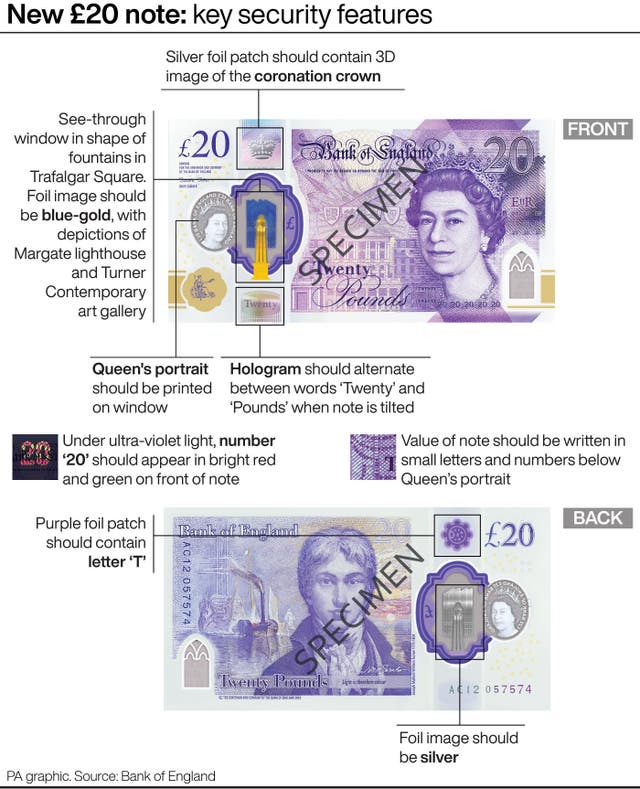JMW Turner £20 banknote enters circulation
The new polymer banknote has been hailed by the Bank of England as its most secure yet.

A new £20 banknote featuring artist JMW Turner will start to appear in ATMs and tills from Thursday as it enters circulation.
The new polymer £20 note will replace the paper £20 note featuring economist Adam Smith and has been hailed by the Bank of England as its most secure banknote yet.
The Bank expects half of all ATMs across the UK to be dispensing polymer £20 banknotes in just two weeks’ time.
The son of a barber and a wig maker, Joseph Mallord William Turner (1775-1851) became renowned as one of the great masters of painting.
He first exhibited at the Royal Academy in 1790 aged just 15.

He became known as “the painter of light” and had a keen interest in depicting nature such as extreme weather conditions and the violent power of the sea.
Features on the new Turner note include:
– A large see-through window with a blue and gold foil on the front depicting Margate lighthouse and Turner Contemporary. The foil is silver on the back. The shape of the large window is based on the shape of the fountains in Trafalgar Square.
– Turner’s self-portrait, painted around 1799 and currently on display in Tate Britain.
– One of Turner’s most celebrated paintings The Fighting Temeraire – a tribute to the ship HMS Temeraire which played a distinguished role in Nelson’s victory at the Battle of Trafalgar in 1805. It was voted the nation’s favourite painting in a BBC Radio 4 poll.
– A metallic hologram which changes between the word “twenty” and “pounds” when the note is tilted.
– A purple foil patch containing the letter “T” and based on the staircase at Tate Britain.
– A quote “Light is therefore colour” from an 1818 lecture by Turner referring to the use of light, shade, colour and tone in his pictures.
– Turner’s signature from his will, in which he bequeathed many of his paintings to the nation.
The paper £20 notes can still be used as normal and the Bank will give six months’ notice ahead of their legal tender status being withdrawn.
There are over two billion £20 notes in circulation.
Laid end to end, two billion polymer £20 notes would stretch around the world almost seven times and weigh the equivalent of more than 141 double decker buses, the Bank said.
The note will join the Sir Winston Churchill £5 and the Jane Austen £10 in the Bank of England’s first series of polymer notes. A new polymer £50 featuring Bletchley Park codebreaker Alan Turing will be issued next year.
Speaking at Tate Britain, which houses the Turner Bequest, Bank of England Governor Mark Carney said: “Our banknotes celebrate the UK’s extraordinarily rich and diverse heritage and highlight the contributions of its greatest citizens. Turner’s art was transformative.
“I am delighted that the work of arguably the single most influential British artist of all time will now appear on another two billion works of art – the new £20 notes that people can start using today.”
Turner’s self-portrait, as featured on the new £20 note, is on display at Tate Britain alongside the banknote.
Home to the Turner Bequest which includes 300 oil paintings and many thousands of sketches and watercolours, Tate Britain will present a major new exhibition dedicated to Turner later this year – Turner’s Modern World.
She said: “Moving the £20 note to polymer marks a major step forward in our fight against counterfeiting. I am very grateful to everyone across the cash industry who has made this transition possible and I hope the public enjoy using their new Turner £20s.”
The Royal National Institute of Blind People (RNIB) has been working with the Bank to make money accessible for people with sight loss.
The new note has tactile markings on it with three separate clusters of dots along the short edge to differentiate it from the £10 note, which has two clusters of dots. It is larger than both the £10 and £5 notes.
David Clarke, RNIB director of services, said: “Handling cash can often be a challenge if you’re blind or partially sighted, because it can be difficult to tell the difference between the different notes and coins. We hope the creation of these notes will help enable people with sight loss to use money more easily and with confidence.
“By incorporating tactile features on money, we are closer to creating a more inclusive society; it’s the small changes that can make a big difference to independent living.”
The Bank has said that polymer notes last longer than paper notes and remain in better condition.
But a previous freedom of information request by the PA news agency found that nearly 50 million plastic £5 and £10 notes have had to be replaced since they were launched by the Bank of England due to wear and damage.
Around 20 million of the Bank’s new polymer £5 notes were replaced in the first three years since they were introduced.
And about another 26 million £10 notes were replaced in the two years since they were launched in September 2017.
Alex Farquharson, director of Tate Britain, said: “We are thrilled that Turner is featured on the new £20 banknote.
“As one of Britain’s greatest artists – perhaps even the greatest – Turner is a key figure in the history of art.”





